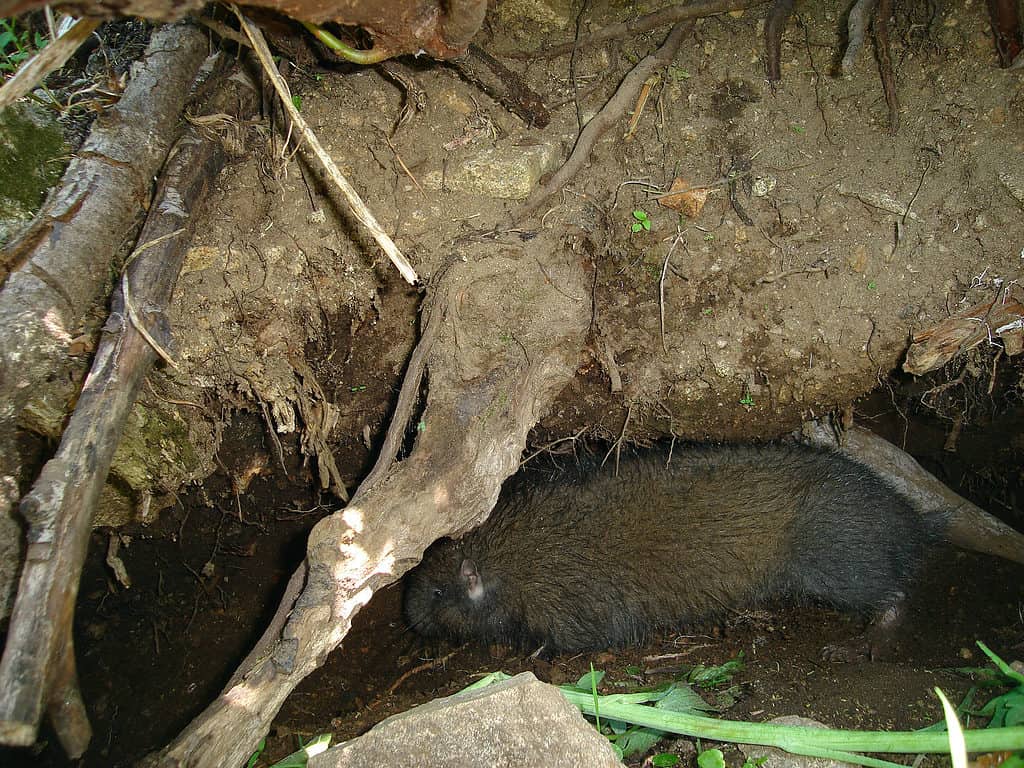Mountain Beaver
Aplodontia rufa
The mountain beaver is a round, stout, archaic rodent that has survived millions of years with primitive features and a herbivorous diet. They digest their food twice, which means... they eat their own droppings!
Advertisement
Mountain Beaver Scientific Classification
- Kingdom
- Animalia
- Phylum
- Chordata
- Class
- Mammalia
- Order
- Rodentia
- Family
- Aplodontiidae
- Genus
- Aplodontia
- Scientific Name
- Aplodontia rufa
Read our Complete Guide to Classification of Animals.
Mountain Beaver Conservation Status
Mountain Beaver Facts
- Name Of Young
- pups, kits, kittens
- Group Behavior
- Solitary
- Colony
- Fun Fact
- The mountain beaver is a round, stout, archaic rodent that has survived millions of years with primitive features and a herbivorous diet. They digest their food twice, which means... they eat their own droppings!
- Estimated Population Size
- 10,000-1,000,000
- Biggest Threat
- human activity
- Other Name(s)
- boomer
- Gestation Period
- 28-30 days
- Age Of Independence
- 8 weeks
- Litter Size
- 2-4
- Habitat
- dense forests and mountains
- Predators
- bobcats, coyotes, owls, fishers, cougars, and bears
- Diet
- Herbivore
- Average Litter Size
- 2
- Lifestyle
- Diurnal
- Common Name
- Boomer
- Slogan
- The beaver that is not a beaver
- Group
- colony
Mountain Beaver Physical Characteristics
- Color
- Brown
- Grey
- Red
- Tan
- Skin Type
- Hair
- Lifespan
- 6 to 10 years
- Weight
- 18-32 ounces
- Length
- 12-20 inches
- Age of Sexual Maturity
- 2 years
- Age of Weaning
- 8 weeks
- Aggression
- Medium
View all of the Mountain Beaver images!
Mountain beavers, also called “boomers”, are not beavers at all. Their name derives from American and European beavers, as they similarly gnaw bark and tree limbs. However, in reality, these rodents are more closely related to squirrels. They are considered pests in the Pacific Northwest due to their destructive behavior toward forests and gardens and do not require a permit for trapping or control. Mountain beavers range from southwestern Canada to central California and western Nevada.
5 Incredible Mountain Beaver Facts
- These creatures eat their own droppings… Gross right? After expelling their food for the first time, they recycle it to absorb any remaining nutrients.
- The mountain beaver is slow to move around. It is rare for them to go too far from their burrows.
- Their teeth are constantly growing. They need to be chewing on something to keep their teeth from overflowing.
- This animal is often referred to as a living fossil due to their primitive features.
- Their sense of sight and hearing is poor, but their sense of smell and touch is well developed.
Scientific Name
Aplodontia rufa
The genus word Aplodintia translates to “simple tooth”. The specific name rufa translates to “red” or “reddish”. Aplodontia refers to the single basin that comprises the bulk of each tooth. The mountain beaver is the only living member of its genus.
Appearance
The mountain beaver is usually either gray or brown, but the colors can range from reddish to blackish depending on the subspecies. They are characterized by their tiny eyes, small rounded ears with a light patch underneath, and opposable thumbs on each foot. These animals have a poor sense of sight and hearing due to their small eyes and ears. They generally weigh between 18 and 32 ounces and are around 12 to 20 inches long – about as long as a bowling pin! Their tails are distinctively short, unlike North American and Eurasian beavers which have tails measuring up to 1.25 feet! The tail length is generally only between 0.37 and 1.57 inches.

The mountain beaver has tiny eyes, small rounded ears, and opposable thumbs on each foot.
©Jacob Kirkland/Flickr – License
Mountain Beaver Evolution and History
This animal is known as one of the most ancient living rodents. With origins tracing back around 50 million years to the Eocene, this animal has survived despite their primitive-like features. These primitive features include the digestive system, the kidneys, and the skull. As the mountain beaver has adapted for burrowing, they can withstand many environmental changes.
Behavior
These creatures are great burrowers. Surprisingly, these rodents do not hibernate during the winter – instead, the rodent stays in its burrow and eats the food that it has stored over the warmer months. Mountain beavers prefer solitude, although you can find them in concentrations that are known as colonies. They are very territorial and will guard their home with aggression. By removing them from their claimed area, you can reduce this aggressive behavior. While they are usually very quiet animals, if they become threatened, they can emit a high pitch whistle to defend their burrows.
Habitat
The mountain beaver prefers moist forests and meadows and is primarily found in the Cascade Mountains of British Columbia and, further south to the Olympic Mountains of Washington and Oregon, as well as some regions of California and Nevada.
The mountain beaver is typically found in forests with dense shrubs and herbs. They build complex burrow systems in the soil, usually in the coniferous and mixed coniferous forests which they inhabit. These burrows have many entrances from the surface that can be extensive. These burrows comprise many tunnels and chambers which interlink one another. They are used for shelter, food storage, and protection from predators. While not so common, mountain beavers are also known to build above-ground lodges made of twigs and trees similar to those of the North American beaver.
Mountain Beaver Diet
The mountain beaver is a herbivore. Their digestive system works similarly to rabbits as microbes help digest the vegetation they eat. These rodents are also able to climb trees to feed!
What Eats the Mountain Beaver?
Being a small herbivore, the mountain beaver has many predators. Known predators include bobcats, coyotes, owls, fishers, cougars, and bears. A decline in the mountain beaver population will affect these animals’ source of food and, therefore, their populations.
What does the Mountain Beaver Eat?
During the spring and summer, the mountain beaver’s diet mainly consists of ferns, grasses, herbs, leaves, and shrubs. During the winter, the mountain beaver’s diet consists of ferns, shrubs, bark, girdling trees, and conifers.
Mountain Beaver Predators and Threats
One significant threat to the mountain beaver is human activity. The mountain beaver is considered a pest in many regions due to the damage caused by the animal. Herbicides and burning are used to reduce the mountain beavers’ food sources. Other threats include wildfires, exotic plants, livestock grazing, rodent control measures, alteration of stream flows, and more.
All this considered, the mountain beaver population is still very stable and labeled least concern by all animal conservation programs.
Mountain Beaver Reproduction
Very little is known about the love lives of these creatures, only that they will begin to reproduce after their second birthday and will typically give birth to two to four babies from February to April, after the breeding season between January and March. The gestation period is only around 28 to 30 days. The babies are born pink with no fur and are generally around 0.9 ounces in weight. The litter usually consists of two or three babies. But in very rare cases, a mountain beaver can have four babies.
Mountain Beaver Babies
The babies are born pink with no fur and do not open their eyes until 50 days. These babies are known as pups, kits, or kittens. After around 8 weeks these kittens can function independently – this is when the kittens are weaned. After a couple more weeks the mountain beaver will move out of the nest and start making their own burrows. These rodents reach sexual maturity at around 2 years of age.
Lifespan
The typical mountain beaver will live between 6-10 years in the wild. In captivity, these animals will live around 6 years. This is relatively short when compared to the North American Beaver, which can live to between 12 and 30 years.
Mountain Beaver Population
This animal is classified as “Least Concern” on the endangered animal list. The IUCN Red List estimates a population of between 10,000 to 1,000,000. Being such a reclusive and nocturnal animal, it is near impossible to have an accurate count, but it is accepted that their population remains stable.
Similar Animals…
View all 164 animals that start with MMountain Beaver FAQs (Frequently Asked Questions)
Are mountain beavers carnivores, herbivores, or omnivores?
Mountain beavers are herbivores that feed on ferns, herbs, shrubs, and more.
What is another name for the mountain beaver?
The mountain beaver is also called a sewellel or a boomer.
Why is the mountain beaver called a beaver?
Although not related to the American and Eurasian beavers, the mountain beaver gets its name as it gnaws at the barks of trees, and cuts off branches.
Are mountain beaver aggressive?
Although not aggressive when left alone, these rodents will stand their ground and confront a threat if threatened.
Do mountain beavers get parasites?
The mountain beaver harbors a parasite that is the largest of its species in the world – the mountain beaver flea.
Can mountain beavers climb?
Yes! They are actually very good at climbing trees to get to the top where they like to gnaw the trees.
Do mountain beavers’ burrows ever get hijacked?
The mountain beaver’s burrow may be claimed by many animal species. Moles, weasels, mink, and even salamanders may choose to move in.
Can mountain beavers swim?
Yes! They are very good swimmers and actually prefer locations close to the seeps and streams.
Thank you for reading! Have some feedback for us? Contact the AZ Animals editorial team.
Sources
- Animal Diversity, Available here: https://animaldiversity.org/accounts/Aplodontia_rufa/
- Nature.org, Available here: https://blog.nature.org/science/2021/03/30/the-mountain-beaver-that-is-not-a-beaver/
- Britannica, Available here: https://www.britannica.com/animal/mountain-beaver

















